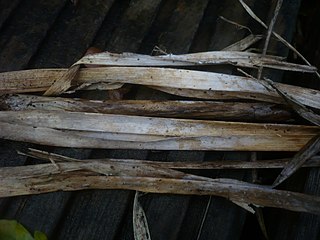
Phanerochaete is a genus of crust fungi in the family Phanerochaetaceae.

The Meruliaceae are a family of fungi in the order Polyporales. According to a 2008 estimate, the family contains 47 genera and 420 species. As of April 2018, Index Fungorum accepts 645 species in the family.

The Phanerochaetaceae are a family of mostly crust fungi in the order Polyporales.

Byssomerulius is a widely distributed genus of crust fungi.

Phlebia is a genus of mostly crust fungi in the family Meruliaceae. The genus has a widespread distribution. Phlebia species cause white rot.

Mycoaciella is a genus of corticioid fungi in the family Meruliaceae. The genus was circumscribed by John Eriksson and Leif Ryvarden in 1978. After microscopic examination of the three species then in the genus, Karen Nakasone proposed to synonymize Mycoaciella with Phlebia.

Phlebiopsis is a genus of poroid crust fungi in the family Phanerochaetaceae. The genus contains 11 species, which collectively have a widespread distribution. The genome sequence of the type species, Phlebiopsis gigantea, was published in 2014.

Hyphodermella is a genus of crust fungi in the family Phanerochaetaceae. It was circumscribed by mycologists John Eriksson and Leif Ryvarden in 1976.

Cystostereum is a genus of crust fungi in the family Cystostereaceae. The generic name combines the Greek word κύστις ("bladder") with Stereum.
Gloeohypochnicium is a genus of wood-inhabiting crust fungi of uncertain familial placement in the order Russulales. Originally conceived by Erast Parmasto as a subgenus of Hypochnicium, Kurt Hjortstam considered it worthy of distinct generic status in 1987. The type species, G. analogum, was described as new to science in 1913 by French mycologists Hubert Bourdot and Amédée Galzin as a species of Gloeocystidium. G. versatum was added to the genus in 2010.

Hyphoderma is a genus of crust fungi in the family Meruliaceae. It was circumscribed by German botanist Karl Friedrich Wilhelm Wallroth in 1833.
Pirex is a fungal genus in the family Meruliaceae. It is a monotypic genus, containing the single crust fungus Pirex concentricus. It is found in the Pacific Northwest region of North America, where it causes a white rot in woody hardwood and conifer debris generated by timber harvesting.

Dentocorticium is a genus of six species of poroid fungi in the family Polyporaceae. The genus was revised in 2018, with several new species added and some older species transferred to other genera, based on phylogenetic analyses.

Epithele is a genus of crust fungi in the family Polyporaceae.
Grammothele is a genus of poroid crust fungi in the family Polyporaceae.

Amaurodon is a genus of fungi in the family Thelephoraceae. Species in the genus have resupinate and corticioid fruit bodies that grow on rotting wood. The hymenophore may have pores, teeth, or be smooth, and is typically blue to green in color.
Phlebiella is a genus of crust fungi in the order Polyporales.
Lyoathelia is a fungal genus in the family Atheliaceae. The genus is monotypic, containing the single corticioid (crust-like) species Lyoathelia laxa. Originally found in Canada, it is now known to occur as well in the United States and Japan.
Pseudolagarobasidium is a genus of nine species of crust fungi in the family Phanerochaetaceae. It was circumscribed in 1985. The type species, P. leguminicola, is associated with stem and root rot of the mimosoid tree Leucaena leucocephala. Pseudolagarobasidium species grow on wood, and may be saprobes, endophytes, or parasites.
Cerocorticium molle is a species of crust fungus in the family Meruliaceae.












